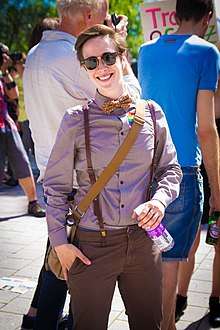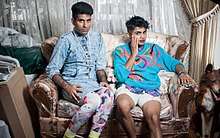Genderqueer fashion

Genderqueer fashion is fashion among genderqueer people that goes beyond common style conventions that usually associate certain colors and shapes with one of the two binary genders. Genderqueer fashion aims to be perceived by consumers as a fashion style that focuses on experimenting garments based on people's different body shapes instead of following the restrictions given by gendered clothing categorization.
Genderqueer style
Genderqueer style is characterized by the choice to not conform to gender norms assigned at birth. Its purpose is to redefine what is considered feminine and masculine.[1]
This differentiation between gender norms through clothing became preponderant during the nineteenth century and it mainly involved different fabrics, trims and constructions for different genders.[2] Those distinctions were meant to mirror gender roles in society as masculine clothing aimed to be practical while female fashion was perceived as purely aesthetic.[2]
Therefore, there is a historical dimension to the association between fashion and gender identity. Nonetheless, gender expression today is recognized by the LGBT community as a very personal and subjective behaviour; genderqueer style is therefore intrinsically tied to identity, and as such, it includes a vast range of aesthetics.[3]
According to contemporary criticism, gender becomes through fashion a form of body style which is a fundamental part of self-realisation and presentation[4] as it creates a bridge between individual identity and society: the genderqueer fashion style tries to recode this relation, although encountering several restrictions in the mass production of commonly binary goods.[5]
These restrictions denote the political nature of genderqueer fashion. According to an article that featured the writer and activist Alok Vaid-Menon,[6] fashion represents the inherent politics of each individual artist or human. For genderqueer people, as for transgender people, whose life and relationship with the body is hardly acknowledged by society, existence itself is political.

Vaid-Menon points out that there is an additional layer of risk for humans assigned male at birth who want to present feminine by wearing dresses and makeup, since the act itself is likely to attract unwanted attention.[6] In Vaid-Menon's words: "There's a material consequence to me presenting feminine, and there's not a material consequence to me presenting masculine, the minute I wear lipstick, or the minute I put on earrings, or the minute I'm wearing a skirt, my entire reality shifts".
In this regard, a 2017 study from Davidson Skylar showed that non-binary people who were assigned male at birth encounter more negative employment outcomes than non-binary people who were assigned female at birth.[7] This phenomenon is considered an aspect of transmisogyny.[8]
Emerging designers
Most mainstream stores separate man and women clothing in different sections, making it difficult for genderqueer people to find clothes that fit. Genderqueer designers are trying to build a bridge between menswear and womenswear by meeting the clothing needs of all identities. For example, the clothing brand NO SESSO specializes in using different prints, fabric and reconstructed materials to dress various body types and gender identities.[9]
Sharpe Suiting is a fashion line that through a Kickstarter campaign was able to manufacture custom-constructed dresswear and a ready-to-wear line for a niche of masculine and androgynous people.[10] Its innovative feature consists in developing a system of measuring and tailoring techniques that minimize female curves of people who don't identify as women. This method is called andropometrics and is an androgynous alternative to the standard anthropometrics method used by most manufacturers.[11]
Maternity lines often include stereotypically feminine elements both in shapes and patterns, as motherhood and femininity are commonly considered to be matching. An alternative was offered by the startup company butchbaby & co, the first wear line for pregnant genderqueer individuals.[12][13]
Global retail brands
Non-conforming fashion styles are gaining acceptance by a larger audience; for this reason, brands such as Zara and H&M are trying to offer unisex clothing lines to consumers by launching gender neutral collections.[14]
These collections are represented by female or male models only.[15] Also, these unisex products display an aesthetic typically considered masculine, both in shapes and colours (grey, beige and brown).[16]
High fashion modeling
Genderqueer fashion is being increasingly recognized by high fashion designers who are now showcasing it on their runaways. For example, during Moschino's Fall 2018 menswear and women's Pre-Fall show, Jeremy Scott presented a gender non-conforming look modelled by nonbinary model Oslo Grace and genderqueer drag queen Violet Chachki.[17] In Violet Chachki's words: "It's very important to have visual representation, to show that queers are important, queers are powerful, queers are beautiful, queers are valid, and you can't erase us".
Moreover, modeling agencies are starting to scout non-binary models.[18] This is the case of My Friend Ned; a South African agency that officially divides its models in male, female and non-binary sections.
Overall, genderqueer representation in the high fashion world appears to be growing and to be increasingly acknowledged by the media. Famous examples of genderqueer/non-binary models are Casey Legler, labelled as the world's first "female male model", Elliott Sailors, Rain Dove, Stas Fedyanin and Erika Linder.[19]
See also
References
- ↑ Brekke, Kira (24 April 2015). "Queer Fashion Is Not A Trend, 'It's A Social Movement'" – via Huff Post.
- 1 2 Y, Kawamura, Fashion-ology: an introduction to fashion studies, Bloomsbury Academy, 2015, p. 124
- ↑ "Op-ed: How Queer Fashion Is Changing the World". 2 September 2015.
- ↑ J, Butler, Performative Acts and Gender Constitution: An Essay in Phenomenology and Feminist Theory, Theatre Journal, Vol. 40, No. 4, 1988, pp. 519-531
- ↑ B, Fine and E, Leopold, The World of Consumption, London: Routledge, 1993
- 1 2 Zulch, Meg. "Why My Outfit Choice Is Always Political".
- ↑ S, Davidson, Gender Inequality: Nonbinary Transgender People in the Workplace, University of Massachusetts Amherst, 2016
- ↑ Serano, Julia. "Trans-misogyny primer" (PDF). Julia Serano. Retrieved 2018-02-23.
- ↑ "NO SESSO Is The Nonbinary Clothing Brand We're Stoked About".
- ↑ Nichols, JamesMichael (12 April 2015). "FABRICATIONS: Meet Queer Fashion Designer Leon Wu Of Sharpe Suiting" – via Huff Post.
- ↑ Nichols, JamesMichael (17 November 2014). "Sharpe Suiting To Design Clothing For Butch, Androgynous And Masculine-Of-Center Individuals" – via Huff Post.
- ↑ "Designing Maternity Clothes for Genderqueer Parents".
- ↑ "What Do Genderqueer Maternity Clothes Look Like?". 12 May 2015.
- ↑ "H&M Is Defying Gender Norms With Their New Unisex Denim Line". 10 March 2017.
- ↑ "Zara joins the gender fluid movement with new unisex range". 7 March 2016.
- ↑ Ferla, Ruth La (19 August 2015). "In Fashion, Gender Lines Are Blurring" – via NYTimes.com.
- ↑ "Violet Chachki on Walking the Moschino Runway and the Importance of Queer Visibility".
- ↑ Ferguson, Sian. "The Fashion Industry Needs to Stop Ignoring Non-Binary Models".
- ↑ "Models crossing gender lines in the fashion industry".